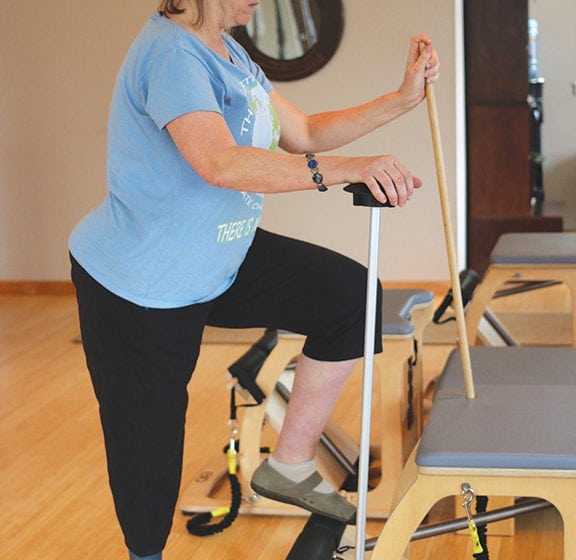By Susan Lazarchick
I started Pilates physical therapy (PT) after falling backward at work in 2014, which resulted in a burst compression fracture of my L-3 vertebra. I had previously been diagnosed with osteopenia, so as a postmenopausal woman I was now doubly concerned about my bone health. I thought strengthening my core muscles would be wise, so I started seeing Amanda Heritage, PT, DPT, and Kelli Velez, DC, CCSP, at Nelson Chiropractic & Pilates Center in New Jersey.
Both have been great support for me. I am stronger, my posture is improved, and I am walking much better since suffering a huge setback after my fall. I can also now participate in a senior Pilates class with limited modifications. I asked Kelli and Amanda to share some information about my progress, which might help other amputees.


Kelli wrote: “It has been exciting to watch Susan’s progress. When she first came to our office, she seemed stuck in a constant state of hip flexion, as if her brain and body simply would not allow her to open up her hip and stand tall. Although myofascial release to the contractures in the front of her hip gave her significantly greater motion, we also addressed underlying instability and neuromuscular control issues in the core and pelvis. This, combined with her work in Pilates and physical therapy, has restored a sense of confidence and control in gait that many amputees struggle with.”
Amanda wrote: “It is a pleasure to accompany patients/clients during their physical therapy journey. And let me say, Susan and I have been on a wild ride together. Many times, during treatment, Susan would look and say, ‘Excuse me? You want me to do what?’ And with every visit, she shocked herself and me, while the brain and body reorganized, stabilized, and optimized her posture, gait, and body mechanics. As a doctor of physical therapy, I use Pilates equipment and movement protocols based on developmental kinesiology (specifically, Dynamic Neuromuscular Stabilization, www.rehab ps.com) to progress patients toward their goals. Using the fluid movements of the Pilates equipment and core stabilization governed by breathing, we can tap into our innate patterns in the brain and promote the core to be the driver of all movements. During our treatments, we focus on ribs over pelvis, like a cylinder, to encourage the core to stabilize the body prior to any movement. This has allowed Susan more confidence and internal strength to venture out more, including participating in a weekly Pilates class. With Susan’s newfound strength and mobility, she has more control of her prosthesis with her daily activities. Mixing up exercises and challenging Susan to [broaden] her never-ending potential is what makes progress happen in PT.”
I am forever grateful for these professionals’ help and often excitedly share with others how much I’ve learned. My goal is to continue in class now that I’ve been discharged from therapy to maintain my newly found strength.
For more information, visit https://mayocl.in/2IDFi8x.



